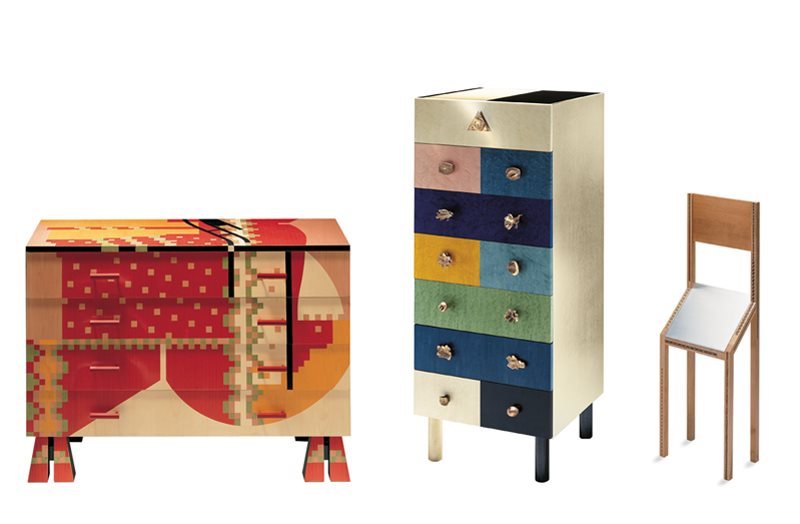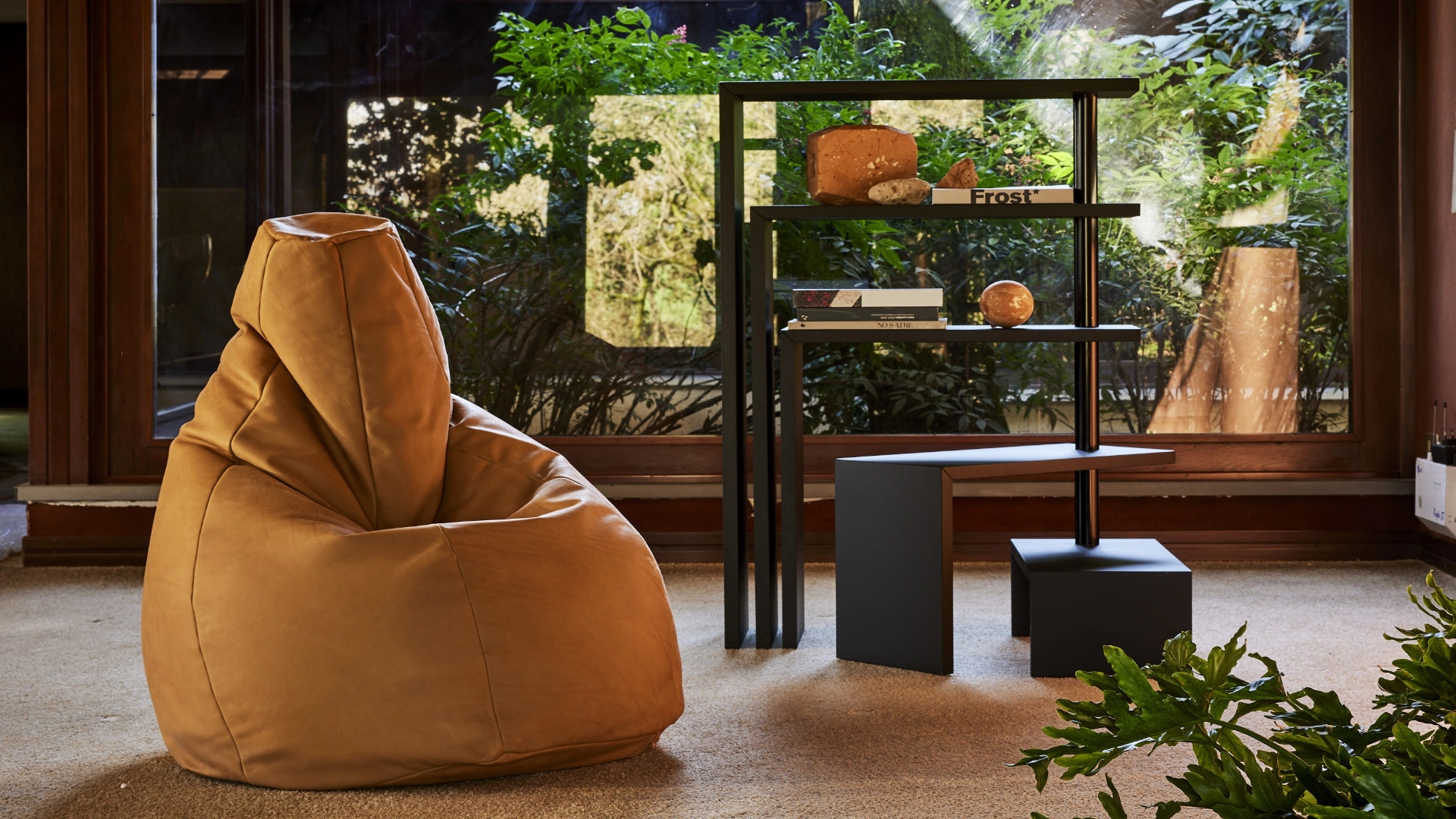This is a collection of designer furniture; all these objects are signed and some are numbered. They are conceived to serve specific purposes in a highly poetic form.
These pieces are contemporary neo-craft products, continuing an ancient tradition of “precious” furniture. This tradition and its techniques have been updated with a new attitude. The Edizioni collection draws on the huge heritage of Italy’s artistic craftsmanship, which was so fecund in the past. In fact, its best traits have been reinterpreted, offering them in an innovative language fitting for today’s taste.
This furniture is delicate, not aggressive: applied-arts products to choose and love, the way one picks and cherishes a painting, a tapestry or a rug. An object that improves ones home artistically. Placing one of these pieces in your own home is an aesthetic choice, just like deciding on an antique that will increase its value in time.
Pierre Restany made the following comment in 1984 when the first “Nuova Alchimia” collection by Alessandro Mendini for Zabro was launched: «The people who use these objects are asked to school their own sensitivity, to discover themselves, to enter the enchanted circle of intellectual ease. They are stimulated to go a little distance beyond the lazy habits of their sensations, the routine of their psycho-sensorial reflexes». Between 1984 and 1986, Zabro’s experimental artistic production had Alessandro Guerriero and Alessandro Mendini as Art Directors. Several furniture collections were launched - Nuova Alchimia by Alessandro Mendini and Bruno Gregori, Animali Domestici by Andrea Branzi - art projects that together with Memphis, of course, represent the most mature efforts in the field of expressive furniture during the 1980s. The enormous quantity of designs and products devised by Zabro was examined, skimming off the purely experimental aspects. What remained formed the core of the Edizioni collection.
Today, it comprises poetic and expressive furnishing elements bearing the labels of designers who work on the borderline between design and art, without the restraints of industrial production. Just a few pieces every year that are carefully selected expressions of first-rate poignant aesthetics.
Zanotta’s goal in this undertaking is to build up an emblematic catalogue of the most significant figurative expressions in our time. A sign that will last forever.
In 1991, thanks to its strong cultural importance, the Zanotta Edizioni project got the Honourable Mention within the valuable Compasso d’Oro Award.
“The Zabro editions that Aurelio Zanotta executed for the New Alchemy in the 1980s were a remarkable training ground for linguistic experimentation. In those days Italian design had forded counter-design, radical design and the early aspects of postmodernism. Zabro’s intense experience provided me, personally, with a concentration of many formal and conceptual hypotheses that Zanotta and Alessandro Guerriero directly, and very quickly, turned into prototypes of furniture, objects and decorations. Zabro was precisely the closing season of the parable of Alchemy, made possible and tied to Zanotta’s expertise of craftsmanship.” Alessandro Mendini, 2003
“These pieces of furniture are designed and built to serve a precise purpose. They are true chests of drawers, true shelves, true chairs, true tables… the continuation of an old tradition of exquisite furniture”. Alessandro Mendini and Alessandro Guerriero, 1984
“One not clearly identified day back in 1987 I went to see my friend Aurelio Zanotta in Nova Milanese. It had been some time since we had seen each other last, at least since the days of the changing fortunes of the Zabro production, started with Alessandro Guerriero and Sandro Mendini. I took him a gift: a small catalogue of an exhibit set up in Zurich with the Society of Artists and Designers, which we had formed with Anna Lombardi and Paolo Scordia. Those objects of ours literally mixed art and design together: painted tables, relief carpets and decorated chaise longues. Aurelio thought about it a while, then told me he would also like to make some objects with some artists whom I could introduce him to. And so we proceeded in this way for some time, meeting friends such as Enzo Cucchi, Mimmo Paladino, Sandro Chia, Riccardo Dalisi… Some of their ideas took form and substance under the label of Zanotta Edizioni. What had been an intuition (the small SAD catalogue was called “Art and Design for the Nineties”) was to reveal itself as being a new and important research current for the more cultivated and refined Italian furniture industry, as Zanotta has always been. Then Aurelio Zanotta passed on, leaving an enormous void inside whoever had known him well, as fortunately happened to me. At a distance of almost twenty years, it is good to know that our ideas and insights of that time still hold value. My wish for the new Zanotta Edizioni is that they live on in the founder’s spirit: courageous, untamable, even headstrong in wanting to achieve authentic innovation of the object and its expressiveness at all costs. Besides, what use is art and design without innovation?” Stefano Casciani, 2006
“The first version of the Mariposa bench was in wrought iron. Aurelio Zanotta then modified it using steel strip that I cut and painted by hand. Every piece was different from the others… the roughness of the cut, that slight vibration of the shape! The adventure I had with Zanotta while working on the Clessidra, Pavone and Mariposa chairs and the Metopa bed was a truly special experience because for me it jelled into a dream even stronger than reality. It was the triple magic of an encounter. That between an uncontrollable Neapolitan creativity (mine) and the absolute expertise and tenacity of the entrepreneurship of the Brianza district (Aurelio’s, first and foremost). It was also an encounter between quality craftsmanship and modern industry, not to mention one between two men enamoured with their work who had a common aesthetic view, even if from two different viewpoints (one as architect and artist, the other as head of a company and talent scout). The Zanotta Edizioni are somewhat the outcome of this relationship and of many other fortunate encounters”. Riccardo Dalisi, 2006
(the Edizioni products mentioned in this article have been discontinued)

